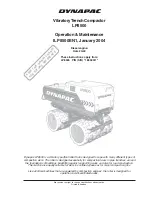
Section 6. Operating and Adjusting Regulations
Belarus 80.1/80.2/82.1/82.2/82
Р — Operation and Service Manual
43
e) keep tyres away from fuel, oil, and
other petroleum products;
f) make it a good habit to inspect the
tyres daily, clean them from foreign
objects stuck in the treads;
g) DO NOT allow operation and/or
parking the tractor on damaged or
flat tyres;
h) comply with the rules of tractor
driving;
i) on long-term outages, place the
tractor on rests, so that the tyres
are clear off the ground.
к) inflate tyres through a pressure
regulator (1) air bleeder valve (see
Fig. 20), by completing operations
as follows:
•
bleed air from pneumatic system
bottle (3) through a condensate
drain valve;
•
screw out butterfly nut (2) of the
bleeder valve coupling union;
•
connect tyre inflating hose to the
bleeder valve coupling union
and tyre valve;
•
switch the compressor on and
inflate the tyre to the required
pressure against tyre pressure
gauge;
IMPORTANT!
At pressure in-
crease in the bottle up to 7.7
kgf/cm
2
,
the
compressor
is
switched over by the pressure
regulator to idling and tyre inflation
operation
stops
automatically.
Hence, the pressure should be
regularly checked against the read-
ing of the gauge located on the
dashboard and, if required, bled
through the condensate drainage
valve.
•
disconnect the hose from the
tyre valve and the bleeder valve
coupling union;
•
switch the compressor off, and
screw on the butterfly nut onto
the bleeder valve coupling un-
ion.
Fig. 20
Liquid Ballast
Filling tyres with liquid ballast shall be
used only in cases of inadequate
road-holding capacity of wheels, or
tyre ground grip, under adverse con-
ditions (such as water-logged soils,
and the like).
NOTE:
Front tyre ballasting is dis-
couraged, since it deteriorates tractor
steerability and handling.
When it is cold, it is recommended to
use a mixture of calcium chloride and
water at a rate of:
Environment tempera-
ture
, °С
Amount of calcium
chloride, g/l water
up to -15°
С
up to -25°
С
up to -35°
С
200
300
435








































